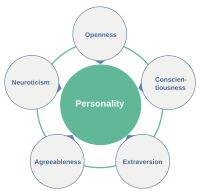
Photo from wikipedia
ABSTRACT General and specific dimensions of psychosis have been identified in both clinical and general population samples. Demographic and clinical correlates, however, have only been explored within models derived from… Click to show full abstract
ABSTRACT General and specific dimensions of psychosis have been identified in both clinical and general population samples. Demographic and clinical correlates, however, have only been explored within models derived from clinical data. Data were drawn from Wave 3 of the National Epidemiological Survey on Alcohol and Related Conditions (N = 36,309). Confirmatory factor analysis and confirmatory bifactor modelling were used to determine the optimal measurement model of psychosis symptoms among this sample. Structural equation modelling was used to identify variables correlated with the different psychosis dimensions, as per the best fitting measurement model. Measurement modelling results indicated that the latent structure of psychosis was best represented by a bifactor model including a general dimension orthogonal to four specific dimensions representing “Positive”, “Negative”, “Mania”, and “Disorganized” symptoms. Childhood interpersonal trauma, lack of social support, lower socio-economic status and suicidal attempts were associated with higher scores on the general dimension. These results provide further support for the validity of a bifactor model of psychosis in the general population and identify unique risk correlates of specific and general factors of psychosis.
Journal Title: Psychosis
Year Published: 2020
Link to full text (if available)
Share on Social Media: Sign Up to like & get
recommendations!